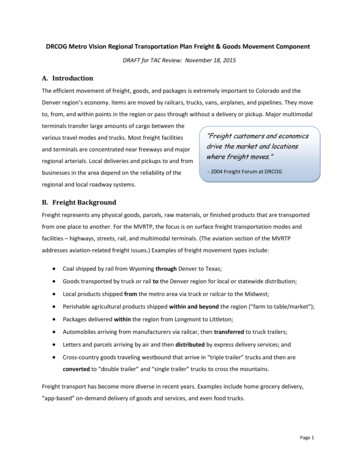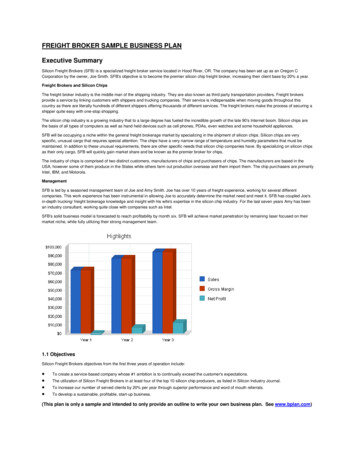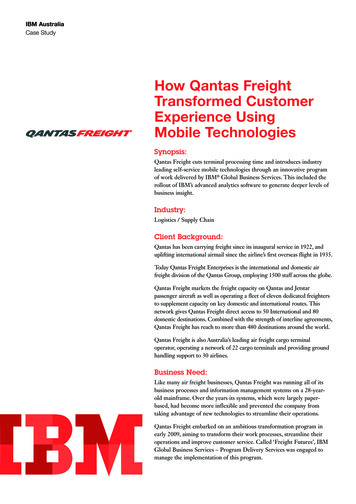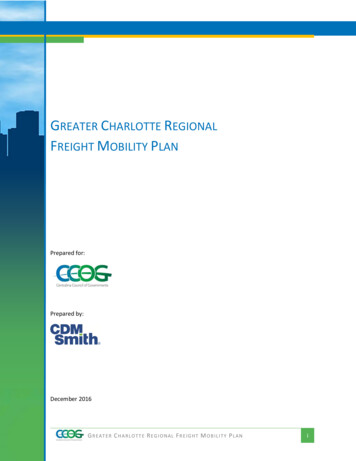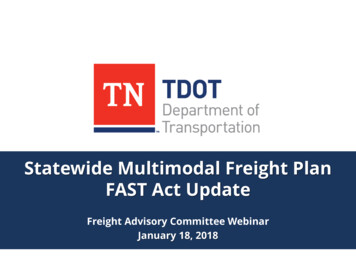
Transcription
Statewide Multimodal Freight PlanFAST Act UpdateFreight Advisory Committee WebinarJanuary 18, 2018
Agenda Overview of the Freight Plan Update for FAST Act Critical Freight Corridors 5-Year Investment Plan– Freight Projects and NHFP Funds Next Steps and Related Items Questions
Overview of TN’sUpdated Freight Plan
The TN Statewide Multimodal Freight Plan1. Strategic Goals2. Economic Context of FreightTransportation Planning3. Freight Policies, Strategies, andInstitutions4. State Freight TransportationAssets5. Conditions and Performance ofthe State’s Transportation System6. Freight Forecast7. Overview of Trends, Needs, Issues8. TN’s Freight TransportationSystem Strengths and Challenges9. The State’s Decision-MakingProcess10. TN’s Freight Improvement Strategy11. Implementation me/longrange-policy/freight-planning.html
Updating the FreightPlan per FAST Act
FAST Act Freight ProvisionsEstablishes the National Highway FreightProgram (NHFP) to enhance efficient movement ofgoods on the National Highway Freight Network(NHFN).The FAST Act requires the establishment of aNational Highway Freight Network (NHFN),which will consist of the following components: The Primary Highway Freight System (PHFS) Critical Urban & Rural Freight Corridors Interstate Routes not on the PHFSRequires each State that receives NHFP funding todevelop a Comprehensive Freight Plan.
Key Goals of the National Highway FreightProgram Investing in infrastructure and operationalimprovements that strengthen economiccompetitiveness, reduce congestion, reduce thecost of freight transportation, improve reliability,and increase productivityImproving the safety, security, efficiency, andresiliency of freight transportation in rural and urbanareasImproving the state of good repair of the NHFNUsing innovation and advanced technology toimprove NHFN safety, efficiency, and reliabilityImproving the efficiency and productivity of theNHFNImproving state flexibility to support multi-statecorridor planning and address highway freightconnectivityReducing the environmental impacts of freightmovement on the NHFN
FAST Act State Freight Plan Components Freight system trends, needs, & issues Freight policies, strategies, & performancemeasures Critical urban and rural freight corridors National freight policy goals Innovative technologies/freight ITS Roadway deterioration Inventory freight mobility issues, such asbottlenecks Congestion mitigation strategies Freight investment plan (projects & funding) Consultation with the State Freight AdvisoryCommittee (FAC)
Updates to the Existing Plan Addresses new national goals Includes freight ITS programs Includes addition of roadway deteriorationdata Incorporates identification of critical ruraland urban freight corridors Includes a 5-year investment plan withprioritized projects & funding allocations
FAST Act Requirements Addressed in PlanAppendix 1FAST Act State Freight Plan Requirement(Section 70202 of Title 49)Location inTennessee Statewide Multimodal Freight PlanAn identification of significant freight system trends, needs, andissues with respect to the State.A description of the freight policies, strategies, and performancemeasures that will guide the freight-related transportationinvestment decisions of the State.Significant freight system trends, needs, and issues impactingTennessee are identified in Chapter 7.Tennessee’s freight policies and strategies are described inChapter 10. Freight performance measures and how they guidefreight-related transportation investment decisions of Tennesseeare described in Chapter 5.Multimodal critical rural freight facilities and corridors designatedwithin the State under section 70103 of this title and critical ruraland urban freight corridors designated within the State undersection 167 of title 23 are listed in Chapter 4.When applicable, a listing of—(A) multimodal critical rural freight facilities and corridorsdesignated within the State under section 70103 of this title; and(B) critical rural and urban freight corridors designated within theState under section 167 of title 23.A description of how the plan will improve the ability of the State tomeet the national multimodal freight policy goals described insection 70101(b) of title 49 and the national highway freightprogram goals described in section 167 of title 23.The national multimodal freight policy goals described in section70101(b) of title 49 are listed in Chapter 1. A description of howthe plan will improve the ability of Tennessee to meet with thenational multimodal freight policy goals and the national highwayfreight program goals described in section 167 of title 23 is inChapter 9. The plan’s alignment with the national freight policygoals is presented in Chapter 10.
FAST Act Requirements Addressed in PlanAppendix 1 (continued)A description of how innovative technologies and operationalstrategies, including freight intelligent transportation systems, thatimprove the safety and efficiency of freight movement, wereconsidered.In the case of roadways on which travel by heavy vehicles(including mining, agricultural, energy cargo or equipment, andtimber vehicles) is projected to substantially deteriorate thecondition of the roadways, a description of improvements that maybe required to reduce or impede the deterioration.An inventory of facilities with freight mobility issues, such asbottlenecks, within the State, and for those facilities that are Stateowned or operated, a description of the strategies the State isemploying to address the freight mobility issues.Consideration of any significant congestion or delay caused byfreight movements and any strategies to mitigate that congestionor delay.A freight investment plan that, subject to section 70202(c)(2) oftitle 49, includes a list of priority projects and describes how fundsmade available to carry out section 167 of title 23 would beinvested and matched.Consultation with the State freight advisory committee, ifapplicable.Consideration of innovative technologies and operationalstrategies, including freight intelligent transportation systems, thatimprove the safety and efficiency of freight movement are includedin Chapter 9 and are further described in Chapter 10.Roadways travelled by heavy vehicles (including mining,agricultural, energy cargo or equipment, and timber vehicles) areidentified in Chapter 4. Roadway conditions which are substantiallydeteriorated are identified in Chapter 5. Improvements that maybe required to reduce or impede the deterioration are described inChapter 10.Facilities with freight mobility issues, such as bottlenecks, withinTennessee, and for those facilities that are State owned oroperated are inventoried in Chapter 5. Strategies Tennesseeemploys to address the freight mobility issues are described inChapter10.Consideration of significant congestion or delay caused by freightmovements are described in Chapter 5. Strategies to mitigate thatcongestion or delay are presented in Chapter 10.The Tennessee freight investment plan, subject to section70202(c)(2) of title 49, is presented in Chapter 11. The freightinvestment plan includes a list of priority projects and describeshow funds made available to carry out section 167 of title 23 willbe invested and matched.Consultation with the Tennessee Freight Advisory Committee forthe initial development of the Statewide Multimodal Freight Planas well as the FAST Act Update are summarized in Chapter 9.
FAST Act Requirements Addressed in PlanAppendix 1 (continued)Item for Review (Section 70202 of Title 49)(a) IN GENERAL. — Each State that receives funding under section 167 of title23 shall develop a freight plan that provides a comprehensive plan for theimmediate and long-range planning activities and investments of the State withrespect to freight.(b) PLAN CONTENTS.See Table 1(c) RELATIONSHIP TO LONG-RANGE PLAN. —(1) INCORPORATION. — A State freight plan described in subsection (a)may be developed separately from or incorporated into the statewidestrategic long-range transportation plan required by section 135 oftitle 23.(2) FISCAL CONSTRAINT. — The freight investment plan component ofa freight plan shall include a project, or an identified phase of aproject, only if funding for completion of the project can reasonably beanticipated to be available for the project within the time periodidentified in the freight investment plan.(d) PLANNING PERIOD. — A State freight plan described in subsection (a) shalladdress a 5-year forecast period.(e) UPDATES. —Response or Location inTennessee Statewide Multimodal Freight PlanThe Tennessee Statewide Multimodal Freight Plan is developed as acomprehensive plan for immediate and long-range planning activities andinvestments for freight.See Table 1 above.The Tennessee Statewide Multimodal Freight Plan is a standalone documentwhich may be incorporated into the TDOT 25-Year Long Range Plan.Chapter 10 includes the fiscally constrained list of projects.The Tennessee Statewide Multimodal Freight Plan includes freight volumes for2012 and forecasts for 2040.TDOT will update the Freight Plan at least once every five years.(1) IN GENERAL. — A State shall update a State freight plan describedin subsection (a) not less frequently than once every 5 years.(2) FREIGHT INVESTMENT PLAN. — A State may update a freightinvestment plan described in subsection (b)(9) more frequently than isrequired under paragraph (1).TDOT will update the freight investment plan as frequently as necessary.
Critical Rural and UrbanFreight Corridors
NHFNTennessee’s Portion of PHFSPHFS - 1,034.31 milesNon-PHFS Interstate - 179.43 milesPercentage of total PHFS - 2.54%CUFC - 105.60 miles (allowed)CRFC - 211.20 miles (allowed) Primary Highway FreightSystem (PHFS) - 41,500miles (adopted in FAST) Interstate Routes not onthe PHFS - 9,500 miles
National Highway Freight NetworkCritical Urban Freight Corridors (CUFCs): Theseare public roads in urbanized areas which provideaccess and connection to the PHFS and theInterstate with other ports, public transportationfacilities, or other intermodal transportationfacilities.Critical Rural Freight Corridors (CRFCs): Publicroads not in an urbanized area which provideaccess and connection to the PHFS and theInterstate with other important ports, publictransportation facilities, or other intermodalfreight facilities.
National Highway Freight NetworkCritical Urban Freight Corridors (CUFCs) – 105.60 miles Large Urban (pop 500K – Knoxville, Memphis,Nashville) Small Urban (pop 50K and 550K – 8 MPOs)Critical Rural Freight Corridors(CRFCs) – 211.20 miles For regions with pop 50K
Critical Rural & Urban Freight CorridorsProcess for Designation Consulted with MPOs and RPOs– Received recommendations for 2,900 milesDetermined high-level distribution of mileage foreach urban and rural area– Used data on population, employment, freightdependent employment, NHS mileage, andtonnage imported and exportedScored eligible corridors based on criteria weightsestablished by the FAC– Amount of truck traffic, number of lity to NHFN, potential to be a parallelfacility for NHFN
Critical Rural & Urban Freight CorridorsProcess for Designation (cont.) Proposed corridors were then selected basedon consideration of the following:– Corridor scoring– TDOT projects that are currently in the pipeline– Projects that are included as part of theStatewide Multimodal Freight Plan– Projects that are consistent with LRTPs and TIPs(in the urban areas)– The current need for improvement Corridors in urban areas 500,000 populationwere endorsed by MPOsAll corridors have been sent to FHWA forapproval
5-Year Investment Plan
5-Year Investment PlanCurateCandidateProject ListScore Eligibility
5-Year Investment PlanCurate Project List 2013 Freight Plan Projects(unfunded and partially-funded) Removed projects completedsince 2013 Added IMPROVE Act Projectsthat were eligible for use ofNHFP funds (Located on NHFNoronProposedCriticalCorridor)
5-Year Investment PlanScore Projects Utilized criteria established by FACs for 2013PlanAssigned relative ranking for each projectDoes project lie on a 'high crash segment'?Safety, Security,Resilience20%State of GoodRepair10%Is the project located on above average (per tonnage) facility?Congestion20%Does the project increase capacity (roadway widening, track additions, lock operating hours)?Does the project parallel an interstate, reinforcing system redundancy?Does the project increase user information?Does the project provide access to an intermodal facility on the NHS?EconomicEfficiency,Productivity, andCompetitivenessDoes the project provide access to an intermodal facility in a bottleneck locations?15%Does the facility carry above average tonnage for identified supply chains?Does the facility carry above average value for identified supply chains?Is the project located within 1, 5, or 10 miles of a freight-dependent industry?AdvancedTechnology10%FAC Input15%Does the project include system management (ITS/Signal Improvement/ Rail crossing/ roads around multi-modal facilities)?Does the project provide information on trip detours around congestion?Did members of the FAC rank this project as a high priority?
5-Year Investment PlanDetermine Available Funds Original Apportionment (2016-2020) 131,378,321FAST Act allows up to 10% of freight funds to beallocated to multimodal (non-highway) projectsDetermine Project Eligibility Took highest scoring projects and all projectseligible for NHFP funds to look at their eligibilityand need for NHFP fundingWorked with TDOT’s Program DevelopmentDivision to determine status of projectsApportioned NHFP FundsFY2016FY2017FY2018FY2019FY2020 23,217,526 22,978,963 25,109,832 28,470,000 31,602,000 131,378,321
5-Year Investment PlanLocation-Specific ProjectsCountyRouteProject DescriptionFuture CommitmentsCumberlandI-40Eastbound near Mile Marker 339 Construct Truck Climbing LaneHamiltonI-75Interchange Modification at I-24ShelbySR-4From the Mississippi State Line to 0.6 miles South of Shelby Drive, From South of Shelby Drive toRaines RoadHaywoodSR-19(Brownsville Bypass), From East of SR-87 to West of Windrow Road (IA)Already CommittedSmithI-40Eastbound near Mile Marker 250 (EPD)(Truck Climbing Lane) - (FP# MP-42 - Let to Contract)BentonI-40West of SR-191 to West of Tennessee River (WB Truck Climbing Lane) - (FP# WP-37 – Let to Contract)Humphreys,HickmanI-40Westbound near Mile Marker 161 (Truck Climbing Lane) - (FP# MP-32 - Let to Contract)SullivanI-81Eastbound Truck Climbing Lane at Mile Marker 60 - (FP# EP-43 - Let to Contract)Dickson,WilliamsonI-40Eastbound near Mile Marker 180 (Truck Climbing Lane) - (FP# MP-33 - Let to Contract)CumberlandI-40Westbound near Mile Marker 326 (Truck Climbing Lane) - (FP # EP-41 - Let to Contract)
5-Year Investment PlanStatewide InitiativesCountyProject DescriptionStatewide Interstate Truck Parking - Through resurfacing, restriping, signing, and other minorparking related improvements increase the number of truck parking spaces along the I-24, I-40, IStatewide65, I-75, and I-81 corridors at existing truck only parking areas, rest areas, welcome centers, andweigh scale complexes throughout Tennessee.Statewide Weigh-in-Motion (WIM) Scales – Add mainline Weigh-in-Motion (WIM) systems (scales,cameras, over-height detection, power and internet connections, signage, etc.) upstream of all 6Statewideexisting truck weigh stations along Interstates I-24, I-40, I-65, I-75, and I-81 and at other locationsthroughout Tennessee.StatewideConduct a study that evaluates container on barge service in the Nashville Area that reviewspotential locations, markets, benefits, and economic feasibility (Container Study)
Next Steps
Next Steps Collect any comments from FAC byJanuary 25. Receive and Update Plan based onFHWA Comments. Final Updated Freight Plan will beavailable online. Future updates to the Freight Plan asneeded.
Related Items State Rail Plan Evaluation of the Freight Planusing INVEST Next FAC Meetings – March/April2018
Casey Langford, Ph.D.Policy Office SupervisorTDOT Long Range Planning DivisionCasey.Langford@tn.gov615.532.5824Freight Planning g-home/longrangepolicy/freight-planning.html
The national multimodal freight policy goals described in section 70101(b) of title 49 are listed in Chapter 1. A description of how the plan will improve the ability of Tennessee to meet with the national multimodal freight policy goals and the national highway freight program goals described in section 167 of title 23 is in Chapter 9.
